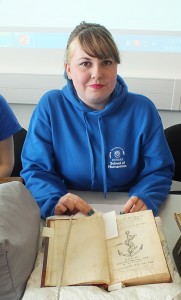 I am a fourth-year student studying Psychology and History as a Joint Honors. I hail from Glasgow. Since reading is my greatest hobby, I decided to take the History of the Book module. After graduation, I should like to pursue a research career.
I am a fourth-year student studying Psychology and History as a Joint Honors. I hail from Glasgow. Since reading is my greatest hobby, I decided to take the History of the Book module. After graduation, I should like to pursue a research career.
Canones Tridentini — The Canons of the Council of Trent (1545-1563)
Bru 270.6 T 795
This copy of the Canons of the Council of Trent (1545-1563) is a fascinating object. Many pages show evidence of a keen reader studying each printed word. These annotations include the underlining of printed words, the insertion of manicules and of hand-written single Latin words or phrases in the margins. The most common handwritten word is ‘nota’, Latin for ‘pay attention’. What we have here is a great example of a reader’s response to a text. The handwritten annotations already start on the title page, where a reader written inside the printer’s device. On pages 9, 12 and 13, you can see an example of the reader underlining certain words. The first manicule occurs on page 14. The manicules get more detailed and elaborate on pages 160, 162, 189, 192, 195 and 210. It suggests to me that the reader sought to emphasize the importance of those particular pages. On page 39, the reader repeats the page number over and over again. On page 118, the number 36 is written in the margin — probably a cross-reference. In all likelihood, the reader was a Protestant. On page 26, we find that many words are underlined. These constitute a list of the canonical books found in Protestant, not Catholic bibles. A watermark can be detected in the flyleaf that precedes the title page.

Comments are closed.